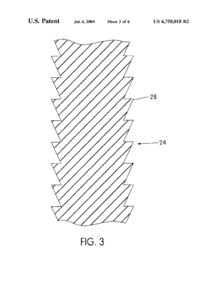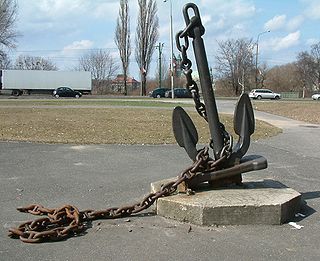
An anchor is a device, normally made of metal, used to secure a vessel to the bed of a body of water to prevent the craft from drifting due to wind or current. The word derives from Latin ancora, which itself comes from the Greek ἄγκυρα.
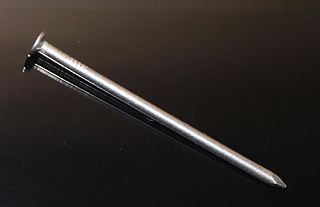
In woodworking and construction, a nail is a small object made of metal which is used as a fastener, as a peg to hang something, or sometimes as a decoration. Generally, nails have a sharp point on one end and a flattened head on the other, but headless nails are available. Nails are made in a great variety of forms for specialized purposes. The most common is a wire nail. Other types of nails include pins, tacks, brads, spikes, and cleats.

Quake is a first-person shooter game developed by id Software and published by GT Interactive. The first game in the Quake series, it was originally released for MS-DOS, Microsoft Windows and Linux in 1996, followed by Mac OS and Sega Saturn in 1997 and Nintendo 64 in 1998. In the game, players must find their way through various maze-like, medieval environments while battling monsters using an array of weaponry. Quake takes inspiration from gothic fiction and the works of H. P. Lovecraft.
The Fujita scale, or Fujita–Pearson scale, is a scale for rating tornado intensity, based primarily on the damage tornadoes inflict on human-built structures and vegetation. The official Fujita scale category is determined by meteorologists and engineers after a ground or aerial damage survey, or both; and depending on the circumstances, ground-swirl patterns, weather radar data, witness testimonies, media reports and damage imagery, as well as photogrammetry or videogrammetry if motion picture recording is available. The Fujita scale was replaced with the Enhanced Fujita scale (EF-Scale) in the United States in February 2007. In April 2013, Canada adopted the EF-Scale over the Fujita scale along with 31 "Specific Damage Indicators" used by Environment Canada (EC) in their ratings.

Louis Cyr was a French Canadian strongman with a career spanning the late 19th and early 20th centuries. His recorded feats, including lifting 500 pounds (227 kg) with one finger and backlifting 4,337 pounds (1,967 kg), show Cyr to be, according to former International Federation of BodyBuilding and Fitness chairman Ben Weider as stated in 2000, the strongest man ever.

A rivet is a permanent mechanical fastener. Before being installed, a rivet consists of a smooth cylindrical shaft with a head on one end. The end opposite the head is called the tail. On installation, the deformed end is called the shop head or buck-tail.

A nail gun, nailgun or nailer is a form of hammer used to drive nails into wood or other materials. It is usually driven by compressed air (pneumatic), electromagnetism, highly flammable gases such as butane or propane, or, for powder-actuated tools, a small explosive charge. Nail guns have in many ways replaced hammers as tools of choice among builders.
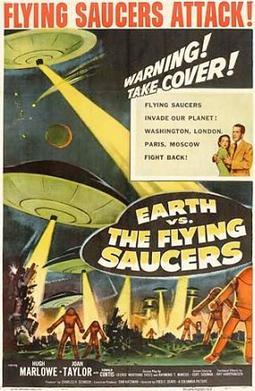
Earth vs. the Flying Saucers is a 1956 American science fiction film from Columbia Pictures. It was produced by Charles H. Schneer, directed by Fred F. Sears, and stars Hugh Marlowe and Joan Taylor. The stop-motion animation special effects were created by Ray Harryhausen. The storyline was suggested by the bestselling 1953 non-fiction book Flying Saucers from Outer Space by Maj. Donald Keyhoe. The film was released as a double feature with The Werewolf.

Framing, in construction, is the fitting together of pieces to give a structure support and shape. Framing materials are usually wood, engineered wood, or structural steel. The alternative to framed construction is generally called mass wall construction, where horizontal layers of stacked materials such as log building, masonry, rammed earth, adobe, etc. are used without framing.
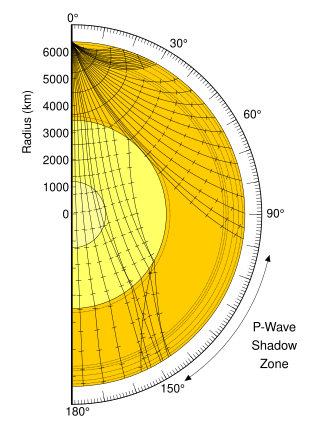
A marsquake is a quake which, much like an earthquake, would be a shaking of the surface or interior of the planet Mars as a result of the sudden release of energy in the planet's interior, such as the result of plate tectonics, which most quakes on Earth originate from, or possibly from hotspots such as Olympus Mons or the Tharsis Montes. The detection and analysis of marsquakes could be informative to probing the interior structure of Mars, as well as identifying whether any of Mars's many volcanoes continue to be volcanically active.

The 2007 Seattle Seahawks season was the franchise's 32nd season in the National Football League (NFL), sixth season in Qwest Field and the ninth under head coach Mike Holmgren. The team improved on their 9–7 record in 2006 and secured its fourth consecutive NFC West division title and its fifth consecutive playoff appearance. Also, the team set an NFL record for the fewest penalties since the NFL expanded to a 16-game season, with 59. In the playoffs, the Seahawks defeated the Washington Redskins in the wild card round, but fell to Holmgren’s former team, the Green Bay Packers, in the divisional round.

Manfred Edward Clynes was an Austrian-born scientist, inventor, and musician. He is best known for his innovations and discoveries in the interpretation of music, and for his contributions to the study of biological systems and neurophysiology.

Bituminous waterproofing systems are designed to protect residential and commercial buildings. Bitumen is a material made up of organic liquids that are highly sticky, viscous, and waterproof. Systems incorporating bituminous-based substrates are sometimes used to construct roofs, in the form of "roofing felt" or "roll roofing" products.

Trident Academy is a school for children with diagnosed learning differences in Mount Pleasant, South Carolina.
Sunil Pradhan is an Indian neurologist, medical researcher and writer, known for the invention of two electrophysiological techniques. He has also described five medical signs, of which one related to Duchenne muscular dystrophy is known as Pradhan Sign, and the others associated with facioscapulohumeral muscular dystrophy (FSHD) and similar neuro diseases. The Government of India awarded him the Padma Shri, the fourth highest civilian award, in 2014 for his contributions to the field of neuroscience.

The 2018 Clemson Tigers football team represented Clemson University during the 2018 NCAA Division I FBS football season. The Tigers played their home games at Memorial Stadium, also known as "Death Valley," and competed in the Atlantic Division of the Atlantic Coast Conference. They were led by head coach Dabo Swinney in his tenth full year and 11th overall since taking over midway through 2008 season.

The 2020 Clemson Tigers football team represented Clemson University during the 2020 NCAA Division I FBS football season. The Tigers were led by head coach Dabo Swinney, in his 12th full year. The Tigers competed as a member of the Atlantic Coast Conference (ACC) and played their home games at Memorial Stadium in Clemson, South Carolina.

UFC Fight Night: Blaydes vs. Lewis was a mixed martial arts event produced by the Ultimate Fighting Championship that took place on February 20, 2021 at the UFC Apex facility in Enterprise, Nevada, part of the Las Vegas Metropolitan Area, United States.

UFC 277: Peña vs. Nunes 2 was a mixed martial arts event produced by the Ultimate Fighting Championship that took place on July 30, 2022, at American Airlines Center in Dallas, Texas, United States.

